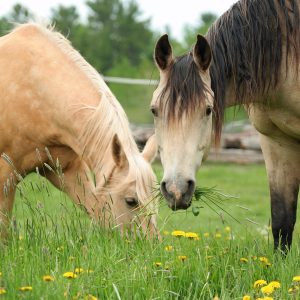
Iron Is an Important and Readily Available Trace Mineral
Iron is considered a true trace mineral. Its main role is to assist in the transportation of oxygen throughout the horse’s body. Iron is required for the synthesis of hemoglobin. Hemoglobin is the pigment found in the red blood cells responsible for picking up oxygen from the capillaries in the lungs and transporting it to other body tissues. Sixty percent of the iron in a horse’s body is involved in oxygen transportation.
It is a common misconception that iron is associated with low energy levels and anemia in horses. In fact, anemia is defined by a reduction of red blood cell mass, not a lack of iron. There is no research supporting iron supplementation to increase athletic ability or daily energy levels.
Iron is measured in an expression of concentration noted as parts per million (ppm). Your horse only needs to consume a small amount of iron daily. The great majority of horses consume adequate iron in their normal diet. Iron is most efficiently absorbed at low levels of intake. Iron absorption decreases as iron consumption increases; however, you can feed too much iron.
*NRC Iron requirements for horses:
-
40 mg/kg of DM per day for mature equines
-
50 mg/kg of DM per day for pregnant or lactating mares
- 50 mg/kg of DM per day for growing horses
*NRC, Nutrient Requirements of Horses, 6th Ed., 2007
DM = dry matter
A small amount of iron is lost in sweat. Intensely exercised horses that sweat a lot might have higher requirements than sedentary horses.
Sources of iron:
Iron can be found in a wide range of equine feedstuffs as well as in the soil. Forages contain between 200-1,000 **ppm iron; grains range between 40-50 ppm; and oilseed meals contain 100-150 ppm. The iron levels in the soil vary depending on soil pH and the presence of other minerals. Soil has been shown to be a significant source of iron for horses. Horses grazing on pasture rarely show iron deficiencies.
**ppm (parts per million) = mg/kg or mg/2.2 lb
Toxicity is more of a problem than deficiency
In the horse, iron toxicosis is a much more common problem than iron deficiency. The horse is very efficient at recycling iron; therefore, there is almost never a net loss of iron from the body of a healthy horse. Horses have no way of excreting excess iron; instead they protect themselves from accumulating excess iron by reducing absorption in the GI tract. Injecting iron bypasses this natural safety measure and increases the risk of developing iron toxicosis.
Consequences of toxicosis
- Increase risk of bacterial infections
- Disruption of proper copper metabolism
- Liver damage in foals
Iron deficiency is a rare occurrence in horses
Iron deficiencies are rare and when they do exist are most commonly caused by blood loss due to severe ulceration, parasite damage, or traumatic injury.
Measuring blood transferrin (iron transport and storage protein) is the best way to test for iron deficiencies. Iron supplementation has not been scientifically proven to increase hemoglobin, packed cell volume, or serum iron. Never supplement with iron without first consulting your veterinarian and testing your horse’s iron levels.


